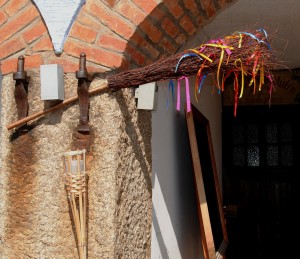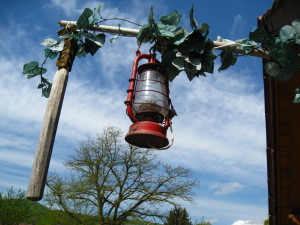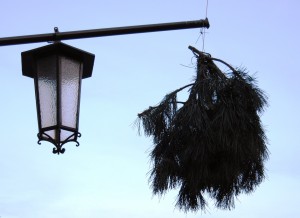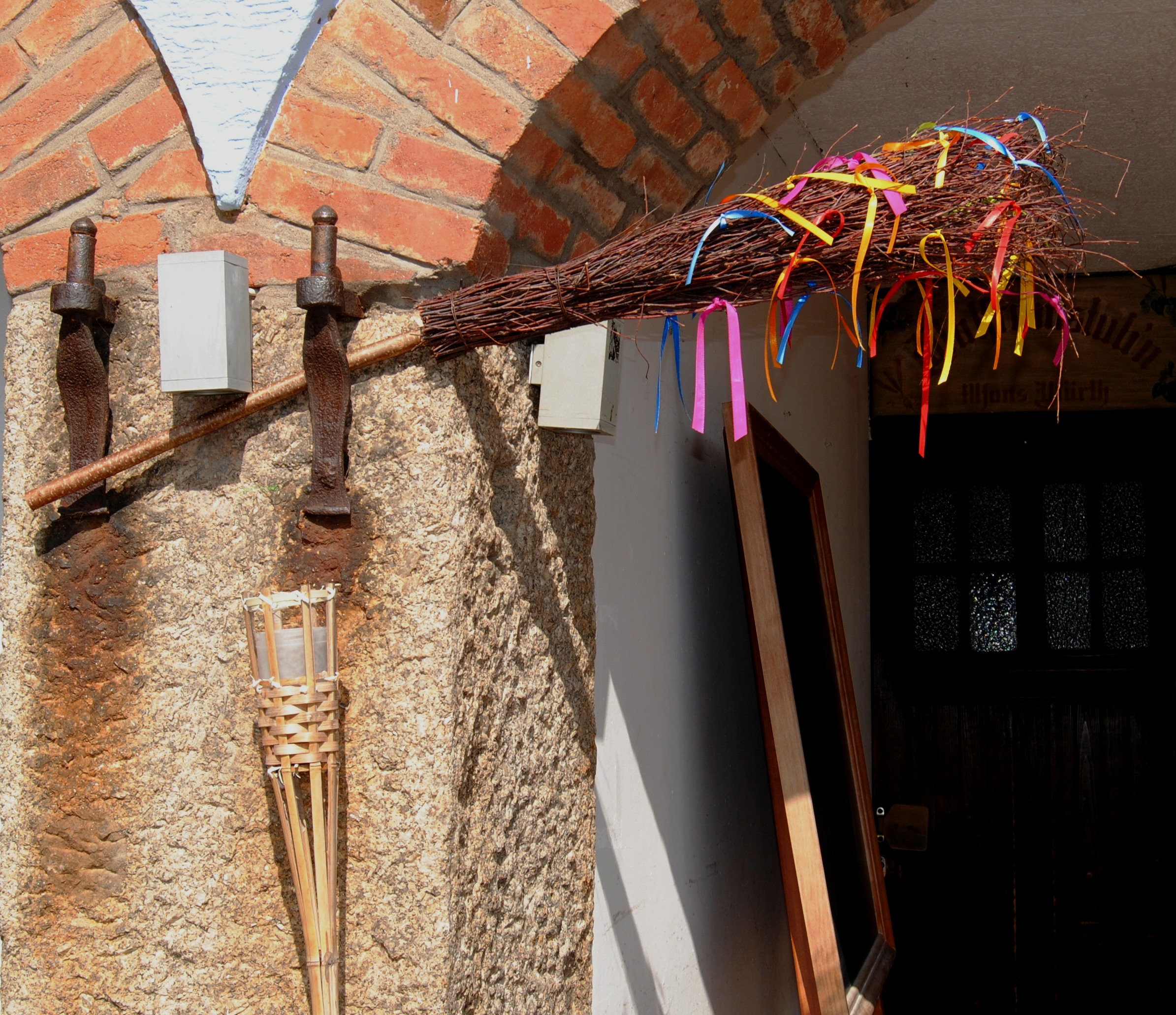
A birch broom, fastened to a post, stands sentinel before a farmhouse in Germany’s vineyards. Red and yellow ribbons flutter from its handle. A board, bearing a hand-painted arrow pointing up the driveway, dangles below the broom.

Vintner’s bushes, as the brooms are called, are a centuries-old European tradition that advertises homemade wine and food in a temporary tavern on the farmer’s homestead. Winegrowers advertise by hanging brooms, bushes, ivy, and wreaths at the entrance to their homes. Shakespeare referred to the tradition when he wrote, “good wine needs no bush.”
Although pub signs replaced Shakespeare’s bush in England, the tradition continues in continental Europe, where the bush’s origins are steeped in controversy. Just how old is it and where did come from? Drawings of the bush date back to the 1400s, but then the trail goes cold. Folklore is harder to track through the history books.
Does the Vintner’s Bush Date Back to Charlemagne?

Continental winegrowers like to say the custom goes back to Charlemagne, the first Holy Roman Emperor. He reigned as king of the Franks starting in 768 and as emperor from 800-814. In response to a famine, Charlemagne introduced a critical piece of legislation called the Capitulare de villis. The emperor wisely required each of his estates to grow and preserve minimum amounts of food. In §22, he specified: “Those who have vines shall keep not less than three or four crowns of grapes.” Because the word for crowns, coronas, can also mean wreaths, many scholars say this statute is the first mention of the vintner’s bush tradition: Charlemagne required the vintners to display their wreaths and sell their wine.
This interpretation of §22 is not unanimous. The leading scholarly interpretation of the Capitulare de villis by the French scholar Guérard says the coronas were wooden wreaths for drying grapes and preserving them as raisins. And that better fits Charlemagne’s legislative intent of preserving the food supply.
Might the Romans Have Invented the Vintner’s Bush?

One scholar suggests we should forget Charlemagne and look much further back in history – to the Romans. In his short article for the American Journal of Folklore, Henry Carrington Bolton points out the diversity of bush types in Italy and pins the tradition to several Latin maxims, attributed to Publius Syrus and Columella in the first century B.C, that say essentially the same thing as Shakespeare: good wine needs no bush. Bolton claims the tradition dates back to the Romans.
A German scholar trumpeted an alarm one year after Bolton’s publication. The quotes Bolton attributed to Publius Syrus and Columella don’t exist. I’ve reviewed the maxims of both Roman authors and have to agree with the German scholar.

But the tradition might still go back to Rome. Consider this: the countries that historically displayed the vintner’s bush, England, Germany, Netherlands, France, Austria, Slovenia, Italy, Spain, and Portugal, correspond roughly to the European boundaries of the Roman Empire. And according to tradition, the founder of the Viennese bush tavern, the Buschenschank, was the Roman legate Galienus. He served wine and nuts to Roman legionaries in the Döbling district of Vienna.
Good wine needs no bush. But sometime the bush is just as interesting as the wine. And it might be much older than people think. So the next time you visit one of these taverns – a Besenwirtschaft or Straußwirtschaft in Germany, a Buschenschank or Heurige in Austria, an osmica in Slovenia, a frasca in Italy, a bouchon in Lyon, France, or furancho in Spain, lift your glass and toast some history. Shakespeare, Charlemagne, and some Roman legionaries might be smiling down on you.
Have you ever visited a farmstead tavern? What did it use as a vintner’s bush?
Literature on point:
Richard Andree, “Der grüne Wirtshauskranz,” Zeitschrift des Vereins für Volkskunde (1907) 17:195-200.
Henry Carrington Bolton, “The Vintner’s Bush: A Survival of Twenty Centuries,” Journal of American Folk-Lore (1902) 15:40.
B. Guérard, Explication du ‘Capitulaire de Villis’ (Paris, 1853)
Bartel F. Sinhuber, Der Wiener Heurige (Vienna: Amalthea, 1986)





I’ve been to two or three vintner’s. I don’t recall the bushes though. The first one was after a 10 mile hike.
The “bushes” in Baden-Württemberg are brooms. If you join me in visiting a Besenwirtschaft in Germany, I’ll point one out to you!
A great article, thank you!!!!!! But the part that reads: “[list of countries] correspond roughly to the European boundaries of the Roman Empire” leads to nowhere. Other regions of Europe (Scandinavia, Russia proper) either don’t poduce wine at all or were part of the Roman Empire also (Hungary, Balkans; why no bushes there?). And why would Anatolia, Syria and Africa be different? If this list of countries point to anything, then it’s more about “Medieval powers” or “descendant countries of the Western Roman Empire,” but hardly about Rome itself. Thankfully, the next sentence, with Galienus and Vienna, adds to the point. The hypothesis is valid and your article is well written and concise, but that sentence’s (lack of) logic simply caught me off guard. Again, thank you!
Thanks for the thoughtful comment, Kasper. Actually, there are some bushes in the Balkans and Hungary has preserved the saying, “good wine needs no bush,” so I can’t rule out the possibility of bushes there. The problem with this kind of research is that it’s so broad and I don’t know the languages that would enable me to properly research the Balkans and Hungary. And yes, you are right about Scandanavia and Russia. Athough Denmark has produced some wine, I don’t think the tradition was a big enough part of its culture to produce the bush. It would be interesting to see if those countries had some variation of the ale-stake, though, because they did have beer.